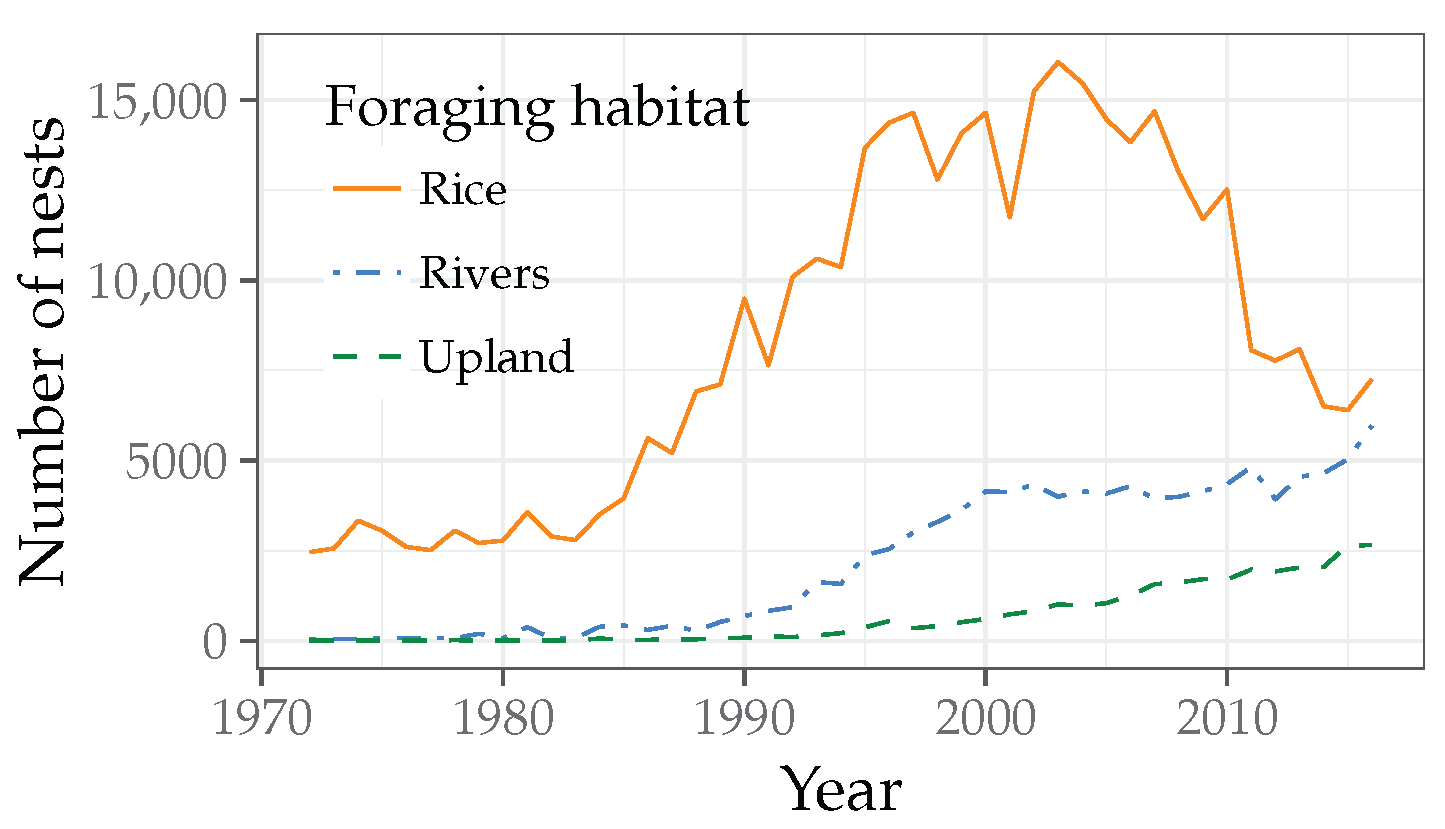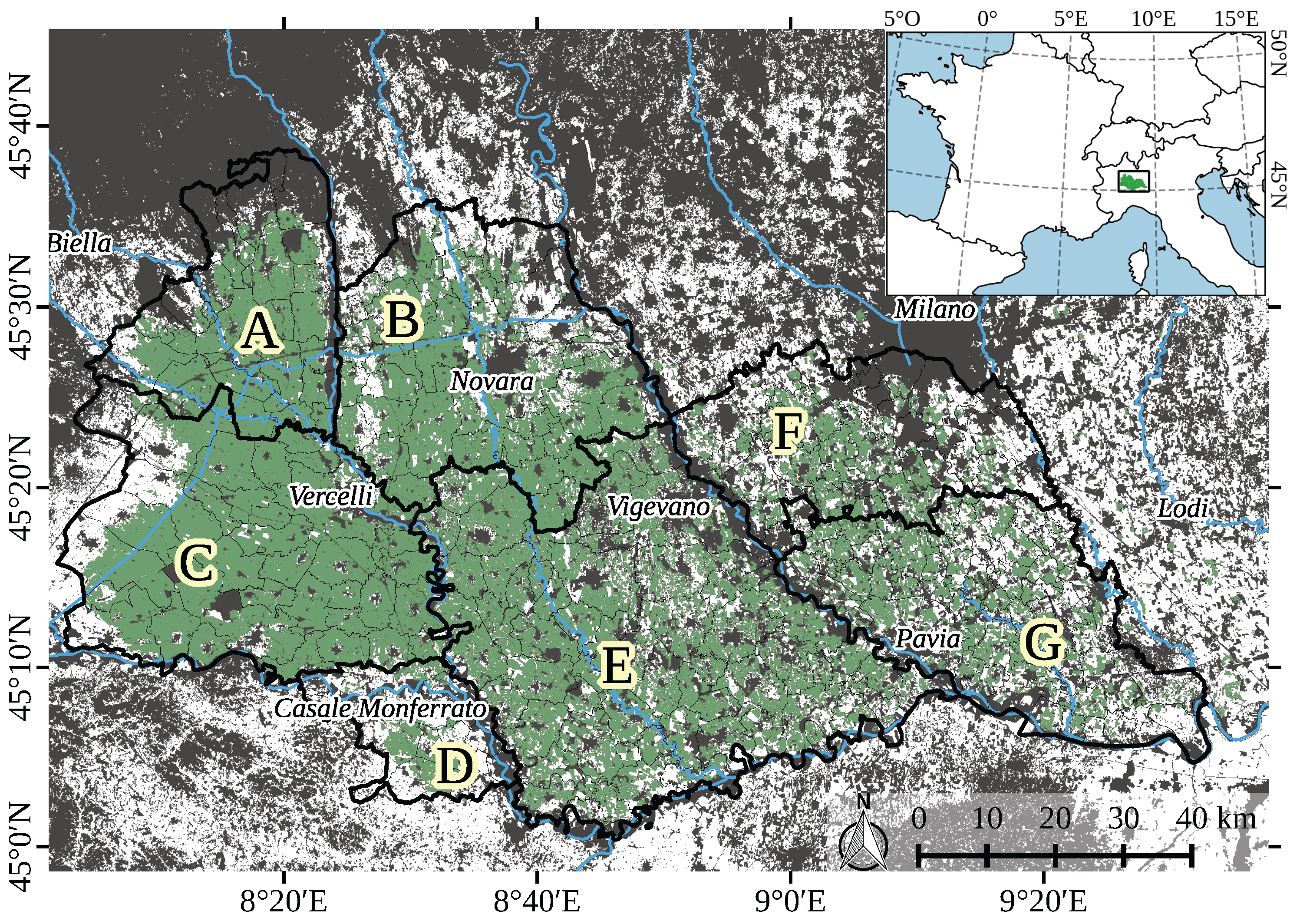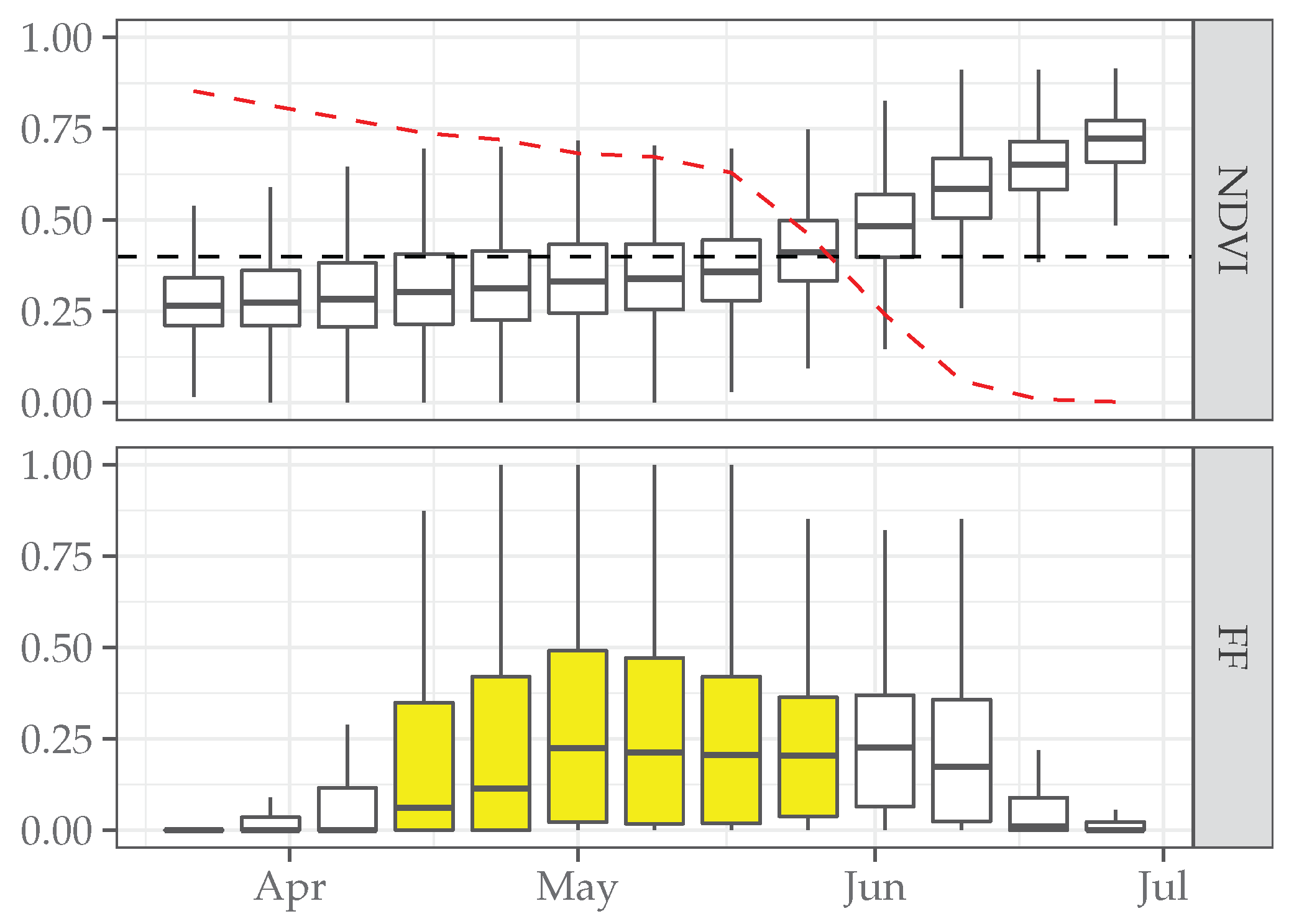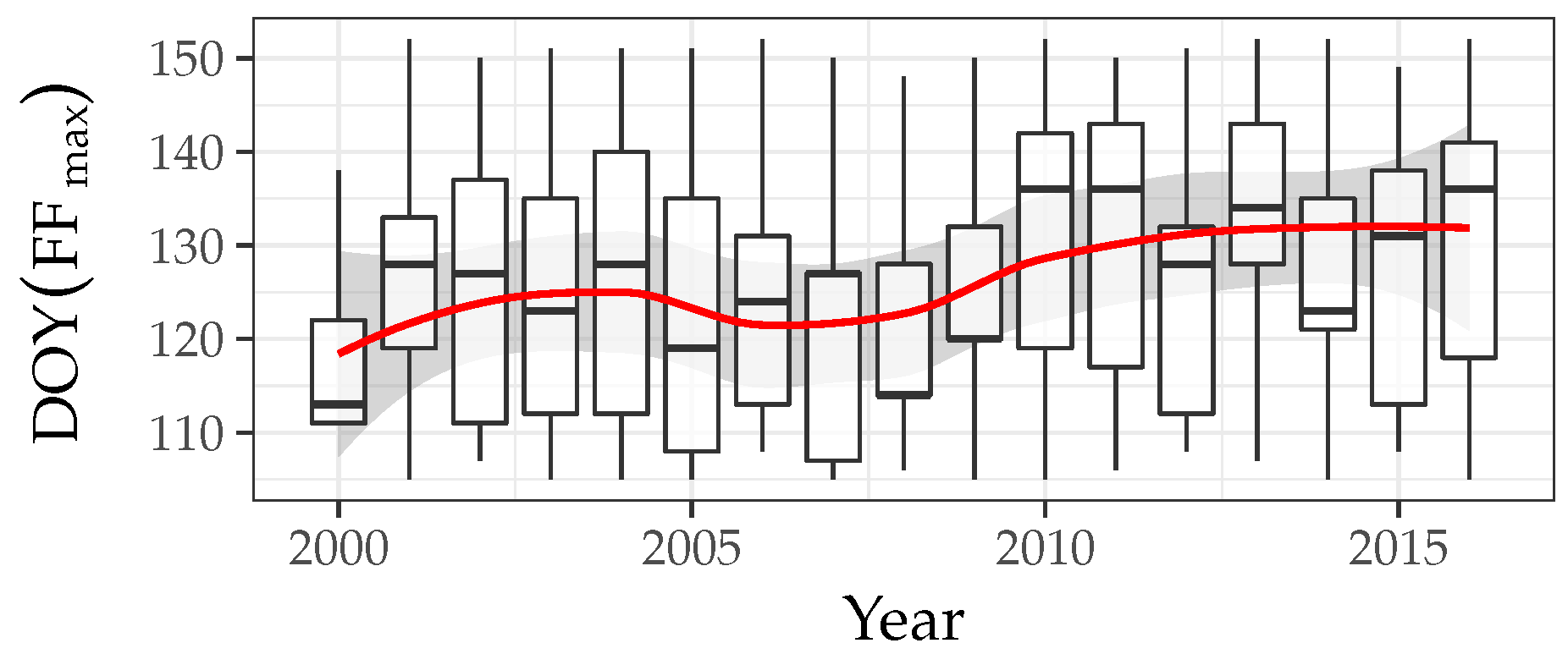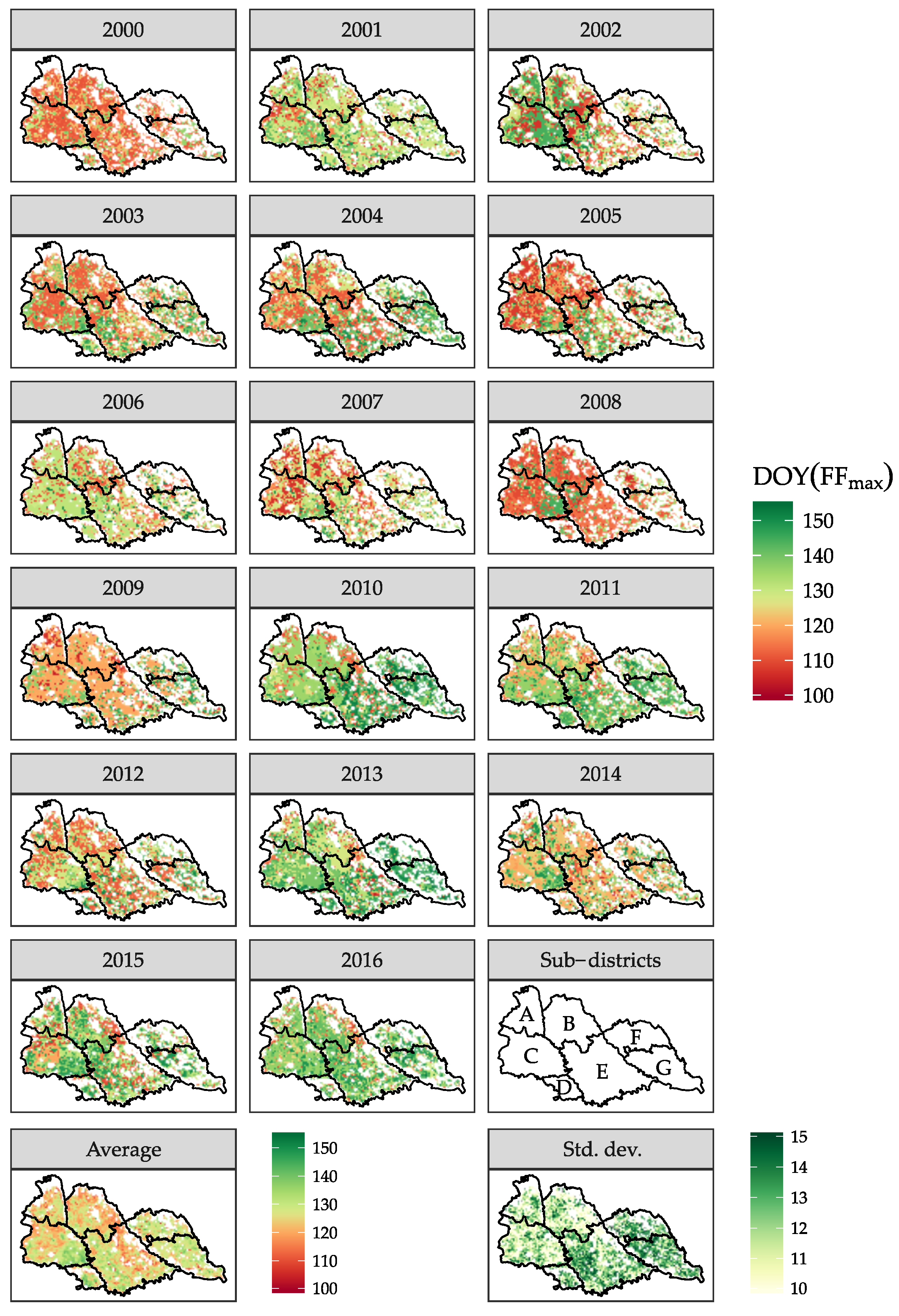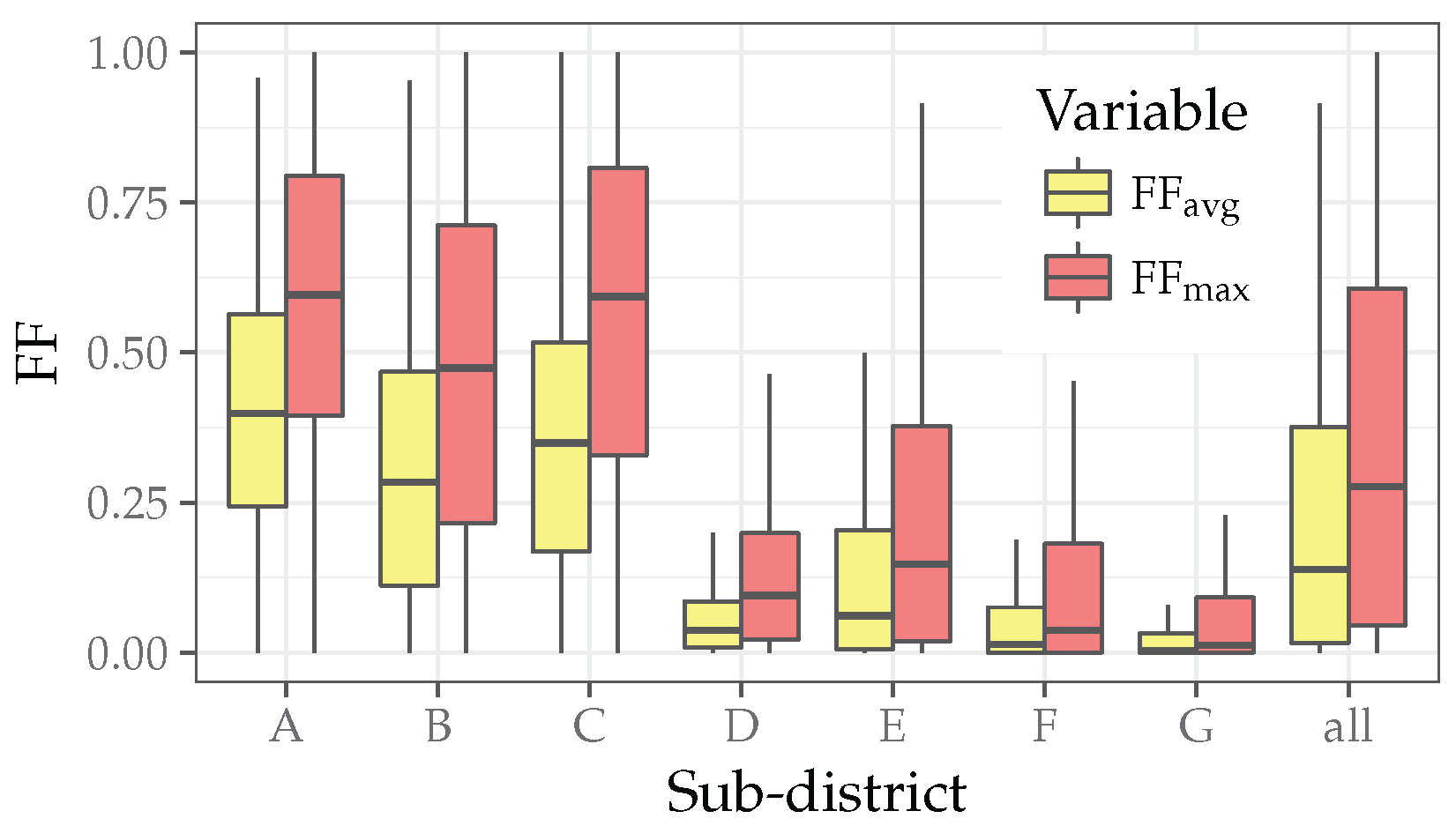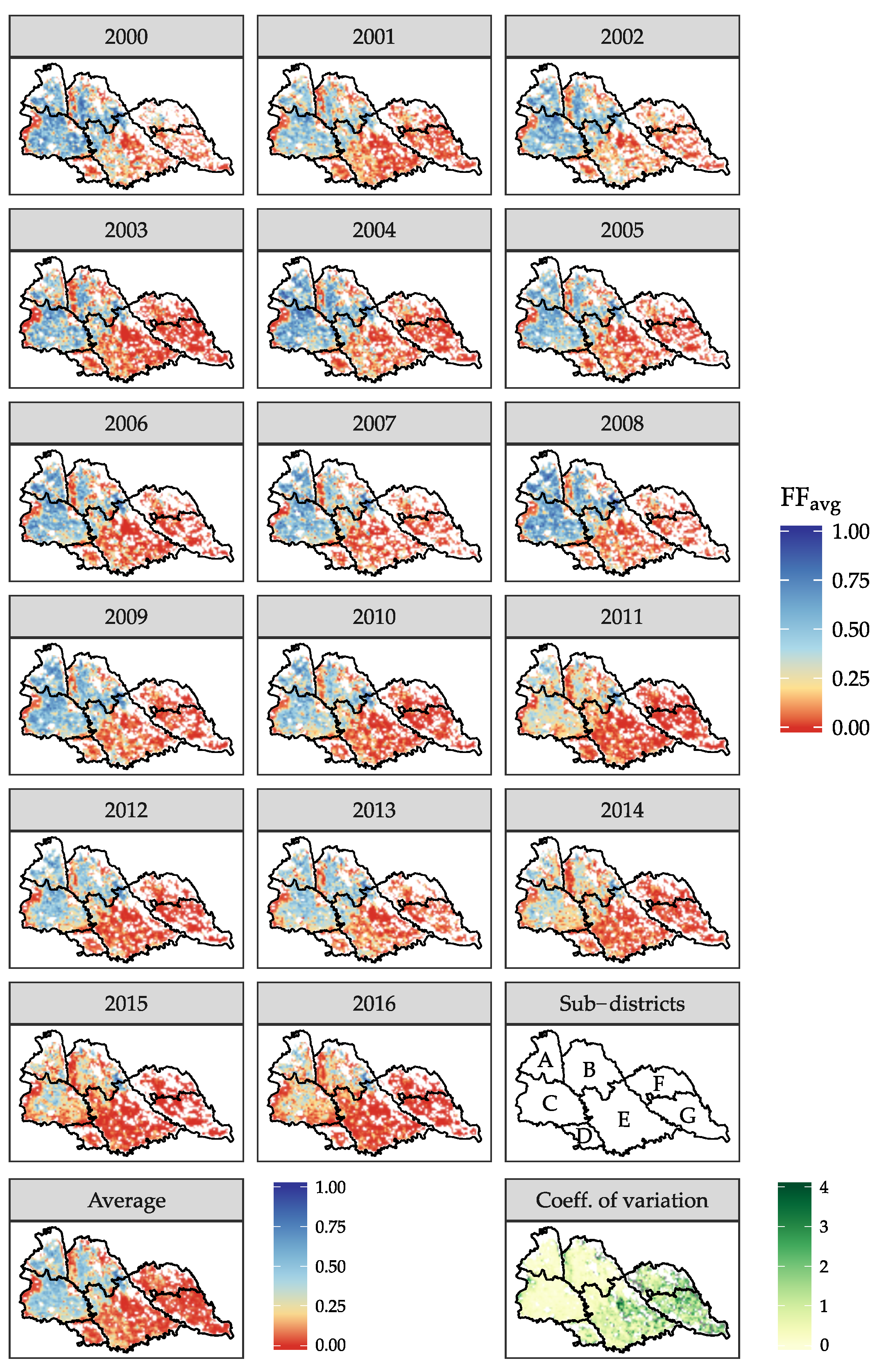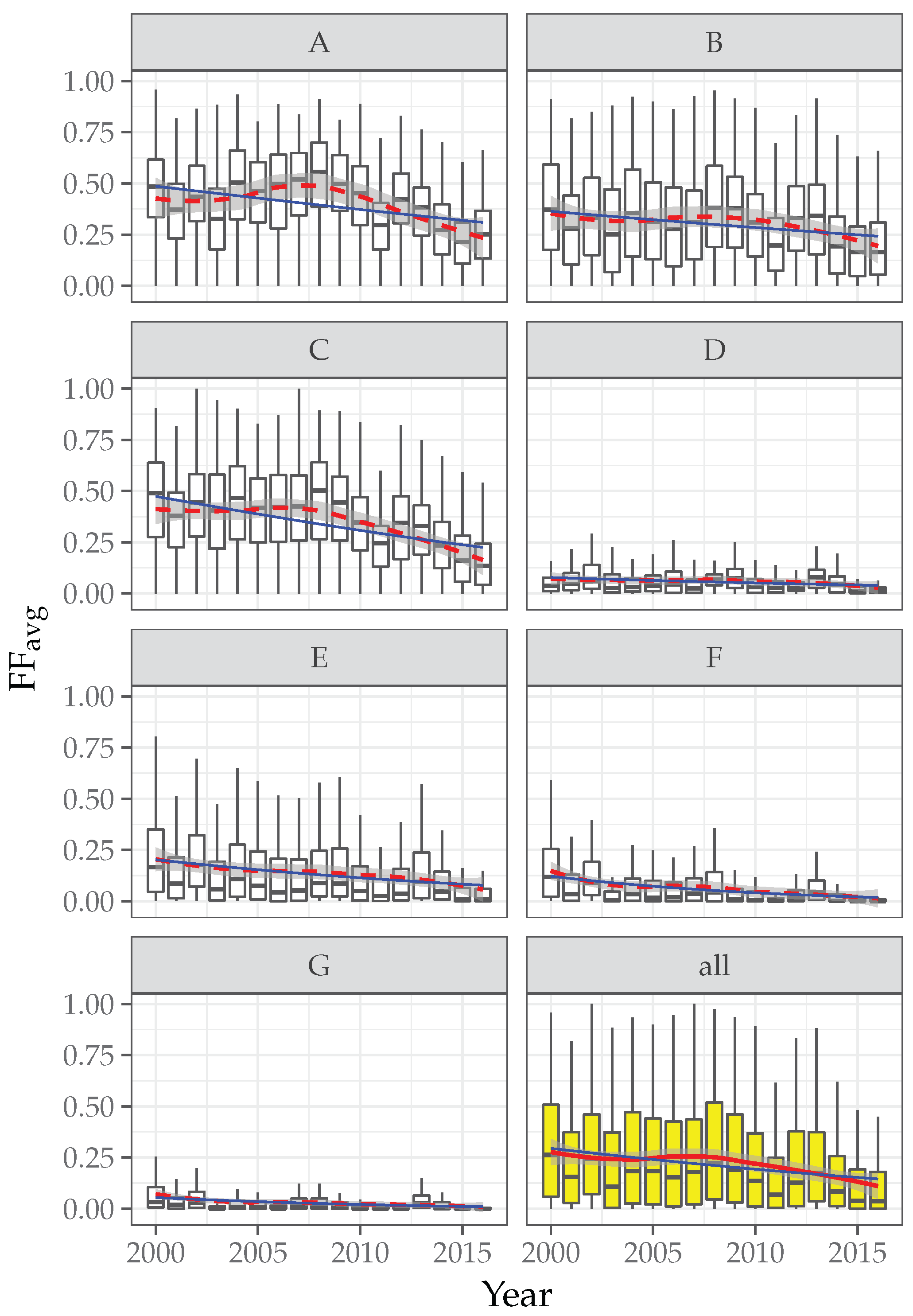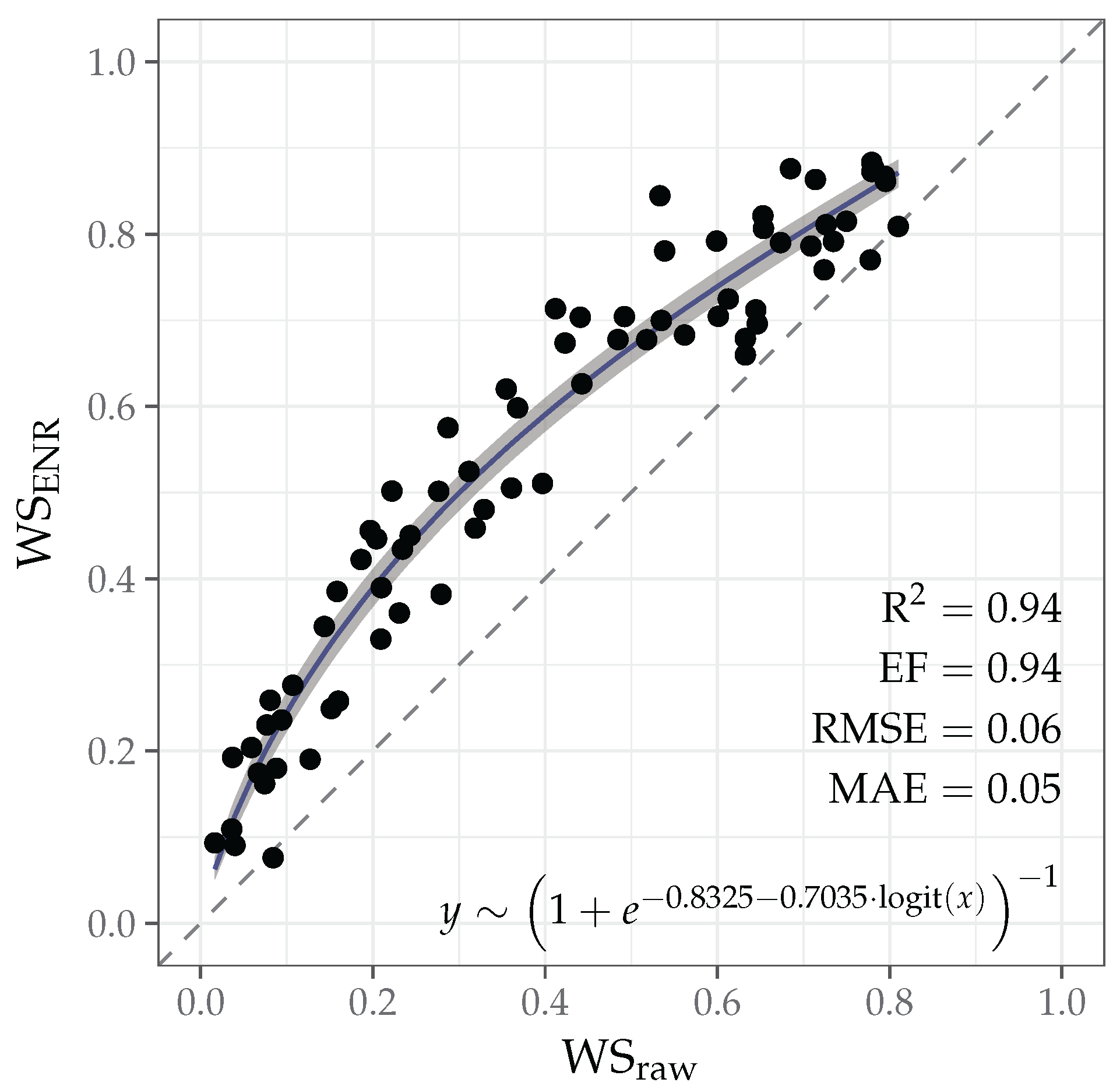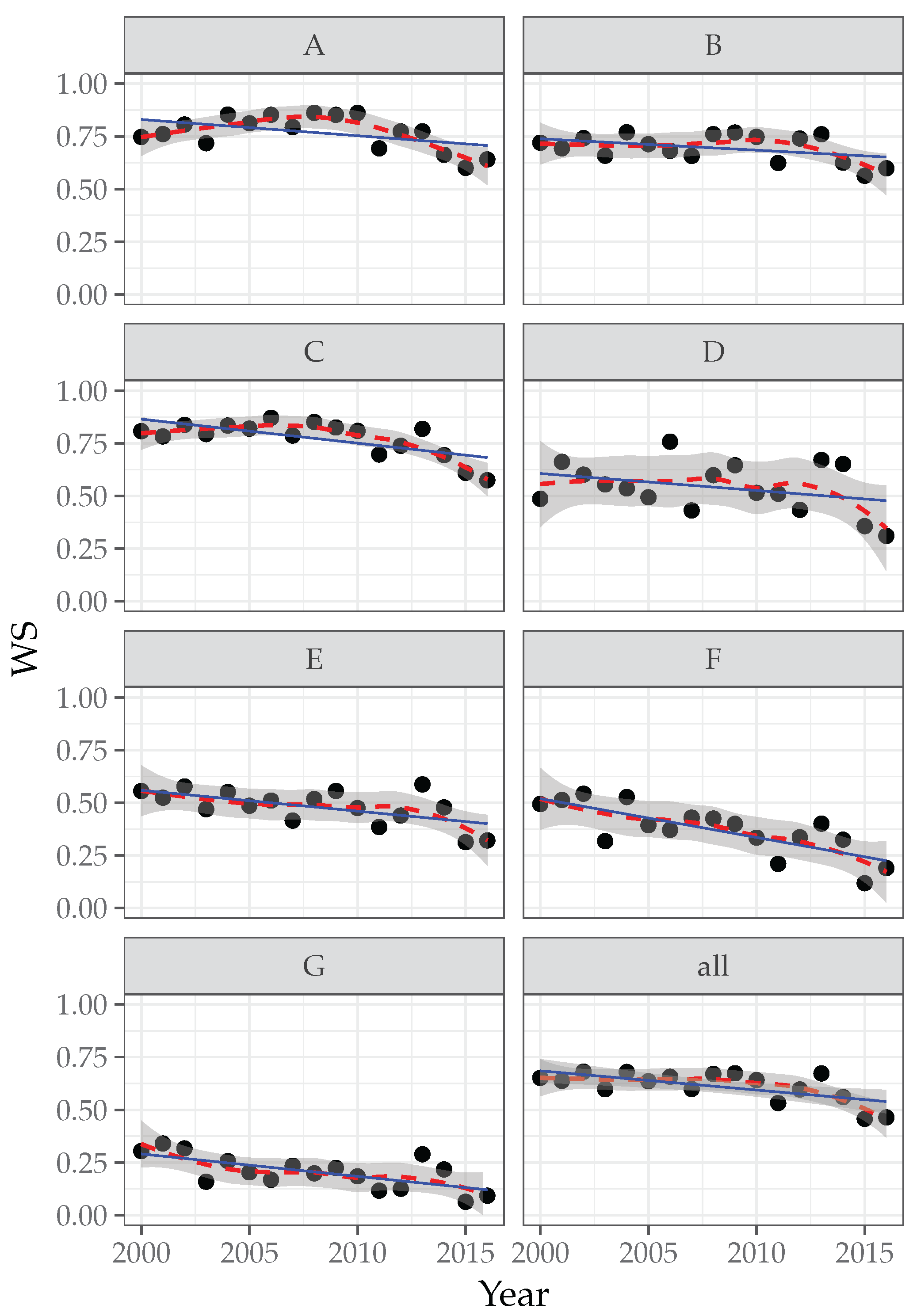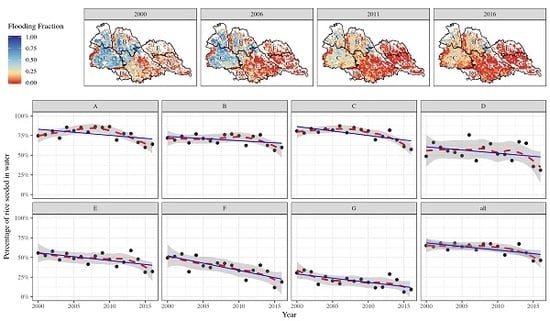3.1. Analysis of the Seasonal Distribution of Flooding Conditions
The seasonal analysis of flooding fraction and NDVI variations allowed detecting the time window during which flooding events are mainly concentrated, and the period in which their detection can be considered reliable (NDVI < 0.4) and related to the sowing phase.
Figure 3 shows the temporal variations of the distribution of NDVI and FF values obtained from MODIS in the analyzed period. Water presence was low in March and at the beginning of April (first three composite boxes), confirming that flooding generally starts after the 10th of April. Moreover, NDVI distributions highlight that, after the end of May, the number of unreliable pixels (NDVI > 0.4, following results reported in Ranghetti et al. [
52]) exceeds that of the reliable ones. This indicates the presence of already grown rice plants, making the FF estimates highly uncertain.
Therefore, analyses of FF and WS temporal trends were based only on images acquired within composite DOYs 105 and 145 (see
Section 2.4.1). It is however important to remind that the aim of this study is to assess variations in flooding conditions during rice-sowing, when the crop is not yet well developed and NDVI is generally low.
The analysis of the temporal changes of maximum FF occurrence (DOY(FF
max); see
Section 2.4.3) highlighted a general delay throughout the whole rice district. The DOY of maximum flooding extent changed from about 120–130 (first ten days of May) during 2000–2009 to about 130–140 (mid-May) in the last seven years (
Figure 4); the univariate linear regression between DOY(FF
max) and year (Equation (
7)) confirms a global change of
days per year (
t = 2.39,
p-value = 0.03). As shown in
Figure 5, the flooding period in the northwestern sub-districts is generally slightly anticipated with respect to the southeastern ones (higher DOY value, although this is not evident in all years), consistent with the fact that northwestern sub-districts, being nearer to rivers, can be the first to receive water when it becomes available in spring. This is confirmed by the ANOVA (
Table 2) of the multivariate regression (Equation (
10)), which points out that most of the variance is explained by the “year” variable (
) and only slightly by the sub-district (
). No difference in the trend between sub-districts resulted from the analysis (interaction between year and sub-district:
,
p-value = 0.94), even if the southeast ones revealed a slightly bigger change (
Figure 5, panel of the standard deviation).
3.2. Analysis of the Spatial Distribution of Flooding Conditions
The spatial distribution of overall flooding conditions during the sowing phase (FFavg) was not uniform, with higher values detected in the northwestern parts of the study area than in the southeastern one.
This difference is also highlighted by
Figure 6, where two groups of sub-districts can be easily identified. While in the entire rice district FF
avg and FF
max, the averages are 0.22 and 0.35, respectively, the values between Sub-districts A-B-C (northwestern part,
and
) and D-E-F-G (southeastern part,
and
) differ considerably.
This is due to various causes, among which: (i) the proportion of rice-cultivated area, which is considerably higher in the northwestern parts, leading to higher FF
avg (see
Table 1); (ii) the greater and earlier adoption of dry seeding in the eastern part, leading to lower FF
max values. Considering the altitudinal gradient of this area, which decreases from northwest to southeast, it is also evident how the averaged flooding fraction decreases from the higher, northwestern sub-districts towards the lower, southeastern ones, in accordance with our knowledge about the geographical distribution of water availability in the study area. Northwestern sub-districts, being nearer to rivers, have higher water availability with respect to the southeastern ones. This probably led to a greater spread of dry seeding in the southeastern sub-districts, as already pointed out in Ranghetti et al. [
52]. The map of the coefficient of variation of seasonal FF
avg values (
Figure 7, last panel) also highlights that the interannual variation of standing water presence is higher in the eastern sub-districts, where water is less available.
Figure 7 finally highlights that Sub-district E (Lomellina) exhibits differences between its northwestern (higher flooding fractions), northeastern (lower values) and southern (intermediate values) parts. This is due to differences in crop fractional cover (rice is dominant in the northwestern and southern parts, while in the northeastern one, other spring crops prevail) and rice practices (water availability is higher in the northwestern part, particularly in the area between Vigevano and Trecate), which make this sub-district fairly heterogeneous. Nevertheless, it was considered as a unique sub-district to simplify interpretation of the results aggregated on administrative boundaries.
3.3. Analysis of Temporal Trends in Flooding Conditions in 2000–2016
The temporal analysis of the seasonal average Flooding Fraction (FFavg) allows identifying and quantifying a decreasing trend in overall flooding conditions during the sowing period (both globally and within each sub-district), as well as identifying differences between sub-districts.
When the whole rice district is considered, the univariate linear regression between FF
avg and year (Equation (
8)) shows a decrease of
% per year (
,
p-value = 0.00059). This metric confirms that flooding practice, hence water diffusion, has been steadily decreasing within the study area.
Results of the ANOVA analysis, reported in
Table 3, allow ascertaining the effect and significance of the different factors (years and sub-districts) and of their interaction. Although most of the variance is explained by the sub-districts (an expected result considering the differences in rice cover and irrigation regimes among sub-districts; see
Figure 6), the effect of year is highly significant. This confirms that the decrease in flooding occurrence highlighted by the previous univariate regression analysis is a common pattern for all sub-districts and was not conveyed by the effect of averaging values from different sub-districts.
The significant sub-district × year interaction, even if low, also suggests that the rate of FFavg decrease varied between sub-districts. This is however influenced by the fact that southeastern sub-districts are characterized by a generally lower FFavg: the slope of the trend line can therefore be expected to be lower even if a similar relative interannual decrease is observed.
Results of the regression analysis conducted at the sub-district level (
Figure 8 and
Table 4) confirm that sub-districts can be split into two groups according to their mean flooding fraction, as already pointed out in the descriptive analysis. In the first group (Districts A, B and C, i.e., the northwestern ones) FF
avg were considerably greater than in the second group (Districts D, E, F and G, i.e., the southeastern part), in accordance with the large amount of variance explained by the sub-district predictor in the multivariate regression (12).
Table 3 also highlights the presence of a statistically-significant decreasing trend for all of the sub-districts. In summary, even if overall flooding conditions are spatially heterogeneous, their decreasing trend is widespread over the whole rice cultivation area, with a minimum decrease of
% per year in Sub-district D and a maximum decrease of
% per year in Sub-district C.
Values of FF
max multiplied by the rice area of each sub-district can be used to quantify the surface that was flooded at least once per year during sowing, a measure that can be considered a proxy of the water-seeded area (
Table 5). Estimated flooded surface has reduced from 2000–2016 in all sub-districts, with a global reduction of 44% and a reduction within sub-districts varying from 24% in Sub-district A to 80% in Sub-district G. This finding is particularly interesting from an ecological point of view: the higher relative flooding decrease, i.e., the loss of foraging habitats for herons and egrets, appears in fact to be located within the eastern sub-districts where also landscape fragmentation is more pronounced, with a potential combined negative effect for waterbird populations.
3.4. Relationships between Raw WS Data and Official Statistics
Results of the logistic regression analysis (see
Section 2.4.2) showed that the estimates of the proportion of water-seeded rice fields within each sub-district obtained from FF
max (WS
raw) are highly correlated (
) with Ente Nazionale Risi official data (WS
ENR) for the period 2004–2015 (
Figure 9). Thanks to this finding, it was possible to use the resulting regression equation as a means to calibrate the WS
raw estimates, thus allowing one to provide unbiased seasonal WS estimates for the different sub-districts for the whole analyzed time period.
WS
raw resulted in being quite underestimated with respect to ENR statistics, likely because a single pixel can contain several paddy fields (more than 20, as the area of one pixel is 86 ha, while rice paddies have an average size of 3 ha [
52]). Therefore, if paddies included in a single pixel are not flooded simultaneously, FF
max may underestimate the fraction of paddies flooded at least once during sowing. In fact, being
the flooding status (zero for dry, one for flooded) of a single paddy
j (
) in a composite image
t (
), the real maximum total extent of flooded surface during sowing should be computed as:
while FF
max was computed as:
where
, connecting Equation (
16) to Equation (
3). From this different computation method, it follows that
on all possible conditions.
However, is not directly calculable from input km maps, since single paddies are not discernible; this consideration justifies the use of an empirical correction of WSraw values to balance the observed bias between FFmax and .
ENR statistics were essential to obtain unbiased WS measures. Nevertheless, the possibility to estimate this variable from satellite data rather than from farmer declarations is important for several reasons: (i) remote sensing provides impartial and spatialized measures, while a map of the paddies is needed to compute the surface area of declared water- and dry-seeded fields (in this case, the area of cadastral parcels was used, which is often not updated and does not correspond to the actual extent of farming parcels); (ii) remote sensing data allow performing retrospective analysis up to early 2000, hence extending the temporal span of the trend analysis; (iii) estimations from remote data can be automatically updated every year (this will allow further extension of the analysis of the detected changes in the future, without requiring additional field/official data); (iv) the satellite-based estimation can be provided earlier in the season instead of waiting for the collection of farmers declaration, since input MODIS products are freely available two weeks after they are collected by the sensor. In conclusion, satellite data allow providing a near-real-time seasonal view of the water extent and easily broaden the analysis of the flooding condition trends in future years.
3.5. Analysis of Changes in the Proportion of Water-Seeded Area
The analysis conducted on the temporal variations of the estimated proportion of Water-Seeded rice (WS) (globally and among sub-districts) provided results quite similar to the ones described for FFavg trends, but with some interesting differences in terms of changes over time.
Results of the ANOVA analysis on the proportion of water-seeded rice fields (
Table 6) show that, similarly to what was observed for FF
avg, the sub-district is the most important factor in explaining WS variance, but year also has a statistically-significant effect. However, differently from what was observed for FF
avg, the interaction between district and year is not statistically significant (
,
p-value = 0.32).
The univariate linear regression over years showed a significant WS decreasing trend of
% per year (
,
p-value = 0.0051). This decrease is similar to that of FF
avg (
% per year) and corresponds to a reduction of
% (
km
2) throughout the whole study period. The analysis within sub-districts (see
Table 7 and
Figure 10) shows that, also in the case of WS, a general decreasing trend is observed in all sub-districts, although some are not statistically significant (i.e., Sub-districts A, B and D).
However, comparing slope coefficients reported in
Table 4 and
Table 7, it can be observed that, while in the case of FF
avg, the greater decrease occurred in the northwestern sub-districts, in the case of WS, the situation is the opposite. This apparent contradiction is justified by the fact that the slope of FF
avg reduction depends also on the different rice fractional cover. A similar relative reduction of FF
avg leads in fact to a larger slope of the regression for sub-districts characterized by a higher FF
avg at the beginning of the period (as in the northwestern sub-district). WS trends do not present this problem and make it possible to analyze the relative variation of the water use within actual rice-cultivated areas directly.
Figure 10 also shows that in Sub-districts A, B and C, the decreasing trend is clearly not constant. The smoothed trends (red dashed lines) show in fact that a marked reduction of WS is evident only in the later years (i.e., 2009 onwards), while in the first ten years, no particular trends are evident. On the contrary, Sub-districts E, F and G show constant decreasing trends, as underlined by the almost coincident smoothed and linear trends.
Moreover, WS values in the first years of the analyzed period are close to one in Sub-districts A, B and C, while they are already close to 0.5 in the other ones (D, E and F), or even lower (G).
This evidence suggests that the lower decrease ratio of WS proportion in the northwestern sub-districts is due to a delayed adoption of the dry seeding practice. Further investigations on WS trends during future years are certainly needed to confirm this qualitative finding and to monitor if the WS proportion reduction will progress in the northwestern area with the same intensity already detected for the southeastern one.
It is also interesting to highlight the anomalous behavior of 2013 in all sub-districts (more evident in the southern ones). This is due to the atypically strong and continuous spring rain occurred during sowing in that year [
79], which forced farmers to sow rice in flooded conditions. This finding is confirmed by ENR statistics (see also
Figure 1 of Ranghetti et al. [
52]).
Monitoring the trends of FFavg in the next few years will be crucial both to: (i) detect cases of extreme reduction of flooded surfaces in the southeastern sub-districts (east of the Ticino river), where the flooding extent is already low and a further reduction could lead to a critical shrinking of feeding habitats for herons and egrets; and (ii) prevent that the spread of dry seeding in northwestern sub-districts reaches the intensities already observed on the southeastern ones.
Comparing
Figure 10 (panel “all”) with
Figure 1 suggests in fact that the temporal trend of flooded surfaces could be associated with the observed reduction in the population size of waterbirds. The number of nests within rice fields (orange line in
Figure 1) showed a decrease between 2000 and 2016 and, similarly to what was observed for WS, which decreased speeded-up since 2010. Nevertheless, in order to understand if there is indeed a causality between the reduction of water-seeded rice area and the number of nests, it would be necessary to study the population dynamics of herons and egrets in combination with other environmental and biological factors. This topic is currently under investigation, and the results of the present study are among the bulk of data under analysis.
